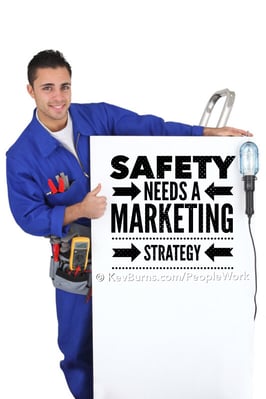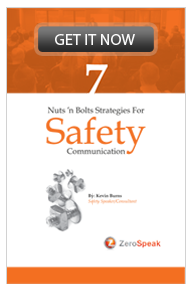Shifting your safety culture from one of compliance and rules enforcement to one of human engagement will require marketing.
 If you think that marketing is all about sales, advertising, and late-night infomercials, then this post should change your mind. Marketing is a way to communicate the “why,” the meaning and importance of safety.
If you think that marketing is all about sales, advertising, and late-night infomercials, then this post should change your mind. Marketing is a way to communicate the “why,” the meaning and importance of safety.
A sign in the workplace that reads, “Stop. Do Not Proceed,” is a warning, and nothing more. It’s a type of communication, but it doesn’t communicate the “why.” Memos, PowerPoint slides, emails, toolbox talks, and safety training are all forms of communication.
You need to take communication to the next level; to create communication that motivates employees. This is where marketing comes into play. In my book, PeopleWork: The Human Touch in Workplace Safety, marketing is discussed as the third critical component of the M4 Method.
Here are three reasons your safety program should have a marketing strategy:
1Marketing Is the ‘Why’ of Action. To most supervisors and safety people, the idea of selling safety is vulgar. Those who have strong beliefs in safety think that safety should sell itself—that people should buy in because it’s the right thing to do. But we know that people don’t always do the right thing. They smoke cigarettes, text while driving, drink to excess, and overeat. People sometimes need a little convincing to make changes in their own best interests. Simply put, marketing is what creates value and motivates people to action - a different action. Marketing helps make a compelling case for “why” employees should choose to take a new action for safety. In order to sell a product, philosophy, or idea, you must have the attention of the listener. Without engagement, the message is not reaching its target. That is one of the key components of selling a message of safety. Marketing gets attention, holds engagement and causes movement.
2Marketing Safety Must Appeal to Hearts and Minds. In order to market something, you have to appeal to the hearts and minds of your buyers. Unfortunately, safety has traditionally focused on appealing only to minds and not hearts. This is why safety buy-in meets resistance: there’s been no establishment of value for the buyer. Safety marketing creates a positive association with safety. It brings safety front and center. Marketing safety, when done right, brings the message home. Safety needs to find its way into the hearts, hands, and minds of crews, customers, and contractors. Workplace safety can bring people together in an emotion-based value system. When done right, marketing can help turn a company’s mundane safety program into a movement built around a set of values, rather than rules.
3Marketing Helps Establish the Win. Safety has overwhelmingly used warnings as a communication strategy. Most of the emotional appeal of warnings is focused on creating a negative emotion, including sad stories of injury on the job. Gruesome photos of dismemberment create emotion, yes—but not the kind that moves people toward something. As a supervisor or safety person, you need to know the answers to the following questions:
- What are the positive aspects of safety?
- What are the benefits of doing safety right?
- What’s the win-win of buying into the safety program?
When you can answer these questions in a way that establishes value for employees, you’ll be on your way to successfully marketing safety. You’ll be prepared to find the win in safety for each of your people, the answer to “what’s in it for me.” A company that can market its products and services to strangers in a compelling way, can also market its safety program to its valuable people. People will gladly buy into something when they can clearly see the benefits of owning it.
 Safety needs to take a lesson from basic marketing. What gets focused on gets talked about, and what gets talked about gets attention. The launch of the latest iPhone or Tesla car model gets attention. Media talk about it. People search online for more information. They even stand in line at retail outlets to be the first to buy. Imagine that kind of reaction to your latest safety initiative.
Safety needs to take a lesson from basic marketing. What gets focused on gets talked about, and what gets talked about gets attention. The launch of the latest iPhone or Tesla car model gets attention. Media talk about it. People search online for more information. They even stand in line at retail outlets to be the first to buy. Imagine that kind of reaction to your latest safety initiative.
You may still be thinking that safety should sell itself. But few products sell themselves. They all need a push. Companies spend money and time marketing their products and services. They market to job seekers and their own employees about the company’s successes and achievements. They even market to their own industry to demonstrate their leadership.
Shifting your safety culture from one of compliance and rules enforcement to one of human engagement will require marketing. Embrace it.
Kevin Burns is a management consultant, international thought-leader in workplace safety, and a speaker based in Calgary, Alberta, Canada. Kevin has authored ten books on human performance and safety, including his most recent release, PeopleWork - The Human Touch in Workplace Safety.
©2016 ZeroSpeak Corporation and Kevin Burns.
No part of this post may be reproduced without the expressed consent of the author.


